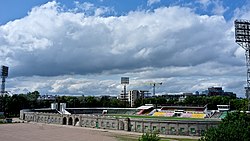Žalgiris Stadium
This article will address the topic of Žalgiris Stadium, which has gained great relevance in recent years. Throughout history, Žalgiris Stadium has been the object of study and interest by experts in various disciplines, and has been a source of debate and reflection for society in general. In order to further understand the importance of Žalgiris Stadium in the current context, different perspectives and approaches will be analyzed that will allow us to obtain a comprehensive vision of this topic. Likewise, the implications that the study of Žalgiris Stadium has in different areas, such as culture, politics, science, among others, will be explored. Through an exhaustive analysis, the aim is to provide the reader with a broad and updated vision of Žalgiris Stadium, providing new reflections and knowledge that contribute to enriching the understanding of this phenomenon.
This article needs additional citations for verification. (July 2016) |
 | |
 | |
| Full name | Žalgiris Stadium |
|---|---|
| Location | Vilnius, Lithuania |
| Coordinates | 54°41′36″N 25°17′25″E / 54.69333°N 25.29028°E |
| Owner | Hanner |
| Capacity | 15,029 |
| Construction | |
| Opened | 1951 |
| Renovated | 1949–1950 |
| Closed | 2011 |
| Demolished | 2016 |
Žalgiris Stadium (Lithuanian: Žalgirio stadionas) was a multi-purpose stadium in Žirmūnai elderate of Vilnius, Lithuania. The stadium held 15,029 and was the largest in Lithuania until its demolition. It had been built on the desecrated graves of Jews interred in the Old Jewish Cemetery under the stadium.
It was named after the Battle of Grunwald and was rebuilt by the German POWs after World War II and finished in 1950 (the stadium existed already before World War II and was used by Pogoń Wilno; in 1936 the Polish athletics championships were held at the stadium).
After independence it was used by the Lithuania national football team, but later it lost its meaning as the national stadium and all the international football matches were played either at Darius and Girėnas Stadium in Kaunas or at the renovated LFF Stadium in Vilnius.
In 2015, the stadium was sold to Lithuanian real estate company Hanner who planned to demolish it and make way for apartments, hotel and offices.
The demolition of Žalgiris stadium was started on 5 July 2016.
References
- ^ "Arvydas Avulis perka Žalgirio stadioną, jo vietoje statys namų už 200 mln. eurų". 15min.lt (in Lithuanian). May 4, 2016. Retrieved July 19, 2016.
- ^ "Vilniuje pradėtas griauti legendinis "Žalgirio" stadionas". lrytas.lt (in Lithuanian). July 5, 2016. Retrieved July 19, 2016.
- ^ Razmaitė, Inga (July 7, 2016). "Griaunamas Žalgirio stadionas – atlaisvinama vieta viešbučiui". vz.lt (in Lithuanian). Retrieved July 19, 2016.